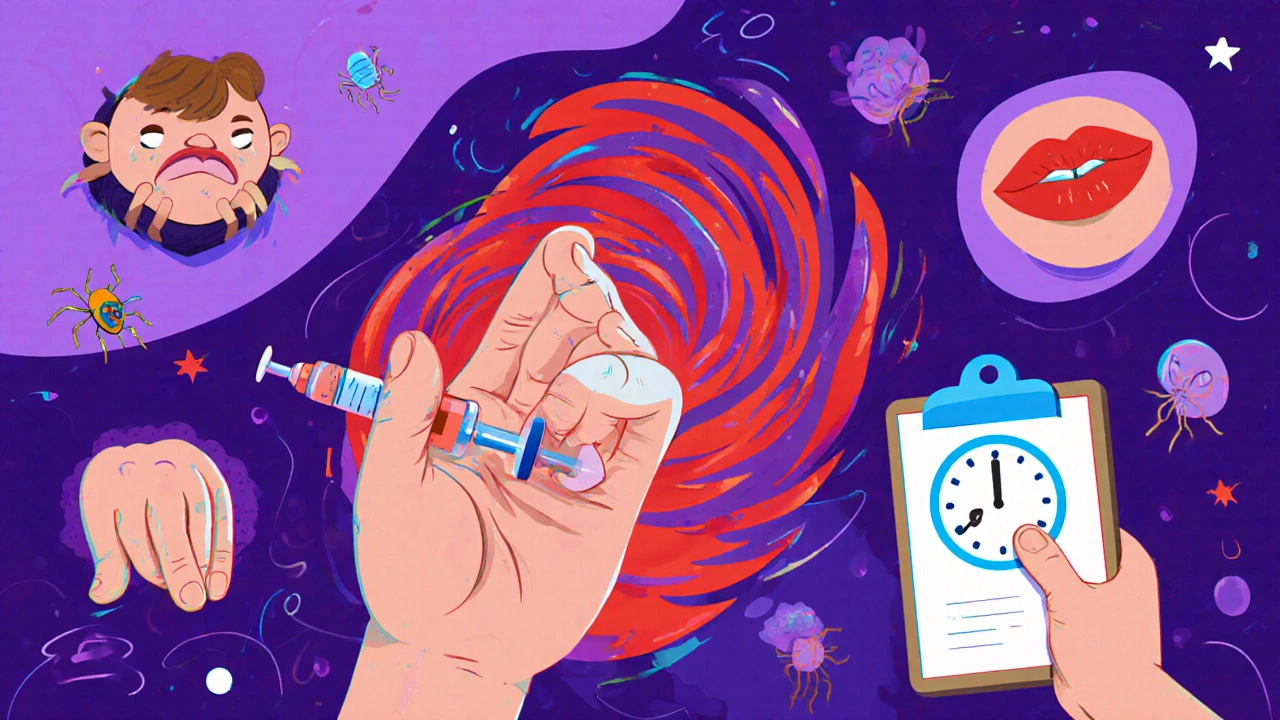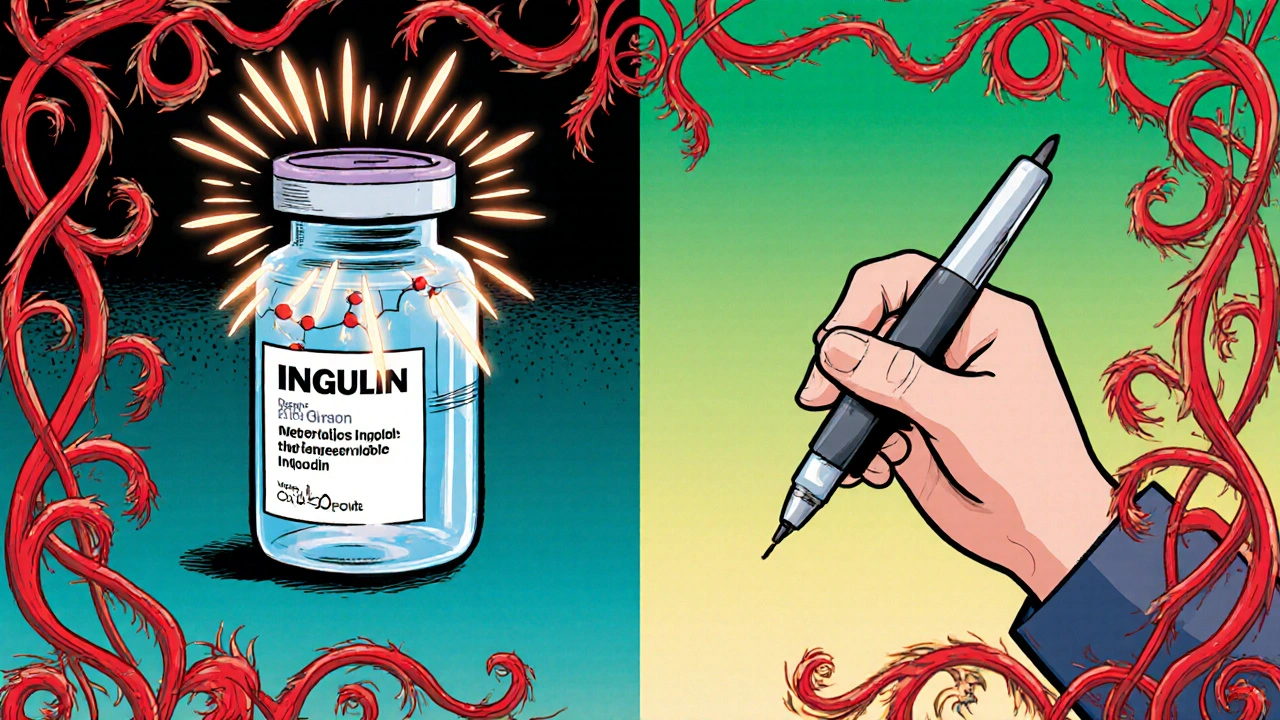
Most people with diabetes rely on insulin to stay alive. But for a small number, that lifesaving treatment can trigger something unexpected: an allergic reaction. It’s not common - affecting fewer than 1 in 50 people on insulin - but when it happens, it can be scary, confusing, and even dangerous. You might notice redness or swelling at the injection site and think it’s just irritation. Or you might feel your throat tighten and wonder if it’s anaphylaxis. The truth is, insulin allergies are real, and they come in different forms. Knowing the difference between a normal side effect and a true allergic reaction can save your life.
What Does an Insulin Allergy Actually Look Like?
| Reaction Type | Timing | Symptoms | Frequency |
|---|---|---|---|
| Localized | 30 minutes to 6 hours after injection | Redness, swelling, itching, tender lumps under the skin | 2-3% of users |
| Systemic | Within minutes of injection | Hives, swelling of lips/tongue, trouble breathing, low blood pressure | Less than 0.1% of users |
| Delayed (T-cell mediated) | 2-24 hours after injection | Joint pain, muscle aches, bruising that lasts 1-2 weeks | Very rare, can occur after years of use |
Not every bump or itch means you’re allergic. Sweating, shakiness, or anxiety after an insulin shot? Those are signs of low blood sugar - not an allergy. True allergic reactions are driven by your immune system. Most are IgE-mediated, meaning your body treats insulin (or something in it) like a threat and releases histamine. That’s what causes hives, swelling, and itching. But some reactions are slower. These are T-cell driven and show up as deep joint pain or bruising that lingers. Even people who’ve used insulin for over a decade can suddenly develop these delayed reactions.
What’s Really Causing the Reaction?
It’s easy to assume the insulin itself is the problem. But often, it’s not the insulin molecule at all. Modern insulins are highly purified, and the protein itself rarely triggers allergies anymore. Instead, it’s the additives - the preservatives and stabilizers - that cause the issue. Metacresol and zinc are common culprits. For example, Humalog contains more metacresol than other insulins, and some people react to that. If you’ve switched from one insulin to another and started having reactions, it might not be the insulin - it’s the filler.
Some reactions only happen with certain brands or batches. That’s why keeping a detailed log matters. Write down: the exact insulin name, the lot number, the time of injection, and what symptoms appeared and when. This isn’t just helpful - it’s critical. Doctors need this data to figure out whether you’re reacting to the insulin, the preservative, or even the needle or alcohol swab.
What Should You Do If You React?
If you notice mild redness or swelling at the injection site that fades in a day or two, don’t panic. But don’t ignore it either. Start by switching injection sites. Rotate your abdomen, thighs, and arms. Avoid injecting into areas that are already irritated. For persistent localized reactions, applying a topical calcineurin inhibitor like tacrolimus or pimecrolimus right after the shot - and again 4-6 hours later - can reduce inflammation. Some doctors also recommend a short course of a mid-to-high potency steroid cream like flunisolide 0.05% for stubborn cases.
But if you feel your throat closing, your tongue swelling, or you’re struggling to breathe - call 999 immediately. Don’t drive yourself. Don’t wait to see if it gets better. Anaphylaxis from insulin can be fatal. Emergency teams will give you epinephrine, antihistamines, and steroids on the spot. This is not something to manage at home.

Can You Still Use Insulin After an Allergy?
Yes - and you absolutely should. Stopping insulin because of an allergy is one of the most dangerous things you can do. Without insulin, your blood sugar skyrockets, and diabetic ketoacidosis (DKA) can set in within hours. DKA is life-threatening and requires hospitalization. The goal isn’t to stop insulin. It’s to find a way to keep using it safely.
Here’s what works:
- Switch insulin types. About 70% of people find relief by switching to a different insulin - for example, from human insulin to a newer analog like insulin glargine or insulin degludec. These have different excipients and lower immunogenicity.
- Try desensitization. Under medical supervision, allergists can slowly introduce tiny, increasing doses of insulin over hours or days. This trains your immune system to tolerate it. Studies show this works completely in two out of three patients and helps the rest significantly.
- Use oral meds if possible. For people with type 2 diabetes, switching to non-insulin drugs like GLP-1 agonists or SGLT2 inhibitors may be an option - but only if your body can still manage blood sugar without insulin. This isn’t an option for type 1 diabetes.
- Get tested. Skin prick tests or blood tests for specific IgE antibodies can confirm whether you’re allergic to insulin or one of its additives. This isn’t a routine test - you need a referral to an allergist who understands diabetes.
One big myth is that skipping insulin doses will help. It won’t. Inconsistent use can make reactions worse or cause them to return after a period of calm. Your immune system doesn’t get used to insulin by skipping shots - it gets more confused.
How Do Doctors Diagnose It?
Diagnosing insulin allergy isn’t straightforward. Most GPs won’t know what to look for. That’s why you need a team approach. Your diabetes specialist and an allergist must work together. The allergist will do skin testing - small pricks or injections of different insulin types and preservatives - to see what triggers a reaction. Blood tests for specific IgE antibodies can confirm the diagnosis. If you’ve had a delayed reaction, patch testing might be used to detect T-cell involvement.
There’s no single test that catches every case. Some reactions are so rare they only show up after years of use. That’s why your own detailed symptom log is so valuable. If you’ve had joint pain every time you used insulin X, but never with insulin Y, that’s a clue.

What’s New in Insulin Allergy Treatment?
Insulin formulations have come a long way since the 1920s, when animal insulin caused allergies in up to 15% of users. Today’s human and analog insulins are far less likely to trigger reactions. But researchers are pushing further. Newer insulins are being designed with fewer preservatives. Some are exploring formulations without metacresol entirely. Continuous glucose monitors (CGMs) are also changing the game - they allow doctors to safely monitor blood sugar during desensitization, reducing the risk of dangerous lows.
There’s still a lot we don’t know. Large-scale clinical trials on insulin allergy are rare because the condition is so uncommon. But the existing evidence is clear: with the right approach, almost everyone can continue insulin therapy safely. The key is acting fast, getting expert help, and never stopping insulin on your own.
What to Do Next
If you think you’re having an allergic reaction to insulin:
- Don’t stop injecting - contact your diabetes team immediately.
- Write down every detail: insulin name, dose, time, symptoms, how long they lasted.
- Take a photo of any visible reaction (redness, lumps, bruising).
- If symptoms are severe - swelling, breathing trouble - call 999.
- Ask your doctor for a referral to an allergist who works with diabetes patients.
Insulin allergies are rare, but they’re real. And they’re manageable. You don’t have to choose between your health and your insulin. With the right diagnosis and care, you can keep living - and thriving - with diabetes.
Can you outgrow an insulin allergy?
No, you don’t outgrow an insulin allergy. Once your immune system has reacted to insulin or one of its components, the sensitivity usually remains. But with proper management - like switching insulin types or undergoing desensitization - you can stop having symptoms and safely continue treatment. The allergy doesn’t disappear, but your body can learn to tolerate it.
Is insulin allergy more common with animal insulin?
Yes, historically it was. In the 1930s, up to 15% of people using animal insulin (from cows or pigs) had allergic reactions. Modern human insulin and analogs are much purer and far less likely to cause allergies. Today, less than 2% of users experience any reaction, and most of those are mild and localized. Animal insulin is rarely used today, so this is mostly a historical concern.
Can you have an allergic reaction to insulin pens?
Yes - but not because of the pen itself. The reaction is still to the insulin or its additives. However, some people report irritation from the plastic or alcohol swabs used before injection. If you switch from vials and syringes to pens and suddenly develop reactions, check whether the insulin formulation changed. Sometimes the same insulin is sold in different delivery systems with different preservatives.
Do antihistamines help with insulin allergies?
They can help with mild, localized symptoms like itching and hives. But they won’t stop anaphylaxis. For serious reactions, epinephrine and steroids are required. Antihistamines are often part of long-term management for persistent mild reactions, especially when combined with topical treatments. But they’re not a cure - they just reduce symptoms.
Why don’t more doctors know about insulin allergies?
Because they’re rare. Most endocrinologists see only a handful of cases in their careers. Many symptoms are mistaken for irritation, infection, or low blood sugar. That’s why it’s so important for patients to speak up, document everything, and push for a referral to an allergist if reactions persist. The more awareness grows, the faster people get the right help.





Dilip Patel
November 13, 2025 AT 13:17Insulin allergies are overblown. In India we use animal insulin even now and no one dies. You people in the US make everything a medical emergency. If your skin itches, use a cold compress. End of story. Stop paying for allergists and fancy tests.
Jane Johnson
November 15, 2025 AT 01:53While the article presents a clinically accurate overview, it fails to adequately address the socioeconomic barriers to accessing allergist referrals and desensitization protocols. Many patients, particularly those without comprehensive insurance, are left to navigate these complexities alone, often resulting in suboptimal outcomes despite the availability of evidence-based interventions.
Peter Aultman
November 16, 2025 AT 18:23Man I had a weird reaction last year after switching to Humalog. Thought it was just a bad injection but the lumps lasted two weeks. Ended up being metacresol. Switched to Basaglar and boom no more issues. Keep a log like they said. It's not magic but it works.
Sean Hwang
November 18, 2025 AT 08:19Been on insulin for 15 years. Started getting joint pain after switching brands. Didn't connect it until my doc mentioned delayed T-cell reactions. Got tested, turned out to be zinc in the formula. Changed insulins, pain gone. Don't ignore weird stuff. Your body talks, you just gotta listen.
Barry Sanders
November 19, 2025 AT 02:53So let me get this straight. People are allergic to a life-saving drug but still want to keep using it? Why not just accept the risk and die? This is why modern medicine is broken.
Chris Ashley
November 19, 2025 AT 23:48Wait so if I use a pen instead of a syringe could that be why I get red spots? I switched last month and now my arm looks like a crime scene. Anyone else?
kshitij pandey
November 21, 2025 AT 23:11My cousin in Delhi had this same issue. She switched from human insulin to degludec and now she's fine. Don't give up. There's always another option. Stay strong and keep track of everything. You're not alone.
Brittany C
November 23, 2025 AT 17:22It's worth noting that IgE-mediated responses are distinct from T-cell-driven inflammation, which necessitates different diagnostic modalities. Skin prick testing has limited sensitivity for delayed-type hypersensitivity, hence patch testing or lymphocyte transformation assays may be indicated in refractory cases.
Sean Evans
November 24, 2025 AT 13:23YOU'RE ALL JUST PANICKING. If you're having reactions, you're probably injecting wrong or using expired insulin. Stop blaming the medicine. My cousin had the same 'allergy' and it was just bad technique. Get your act together. 🤦♂️